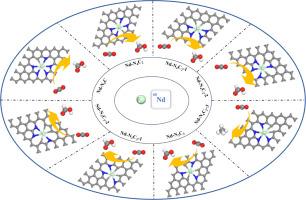Rare-earth metal neodymium anchored into graphene as a promising CO2 reduction electrocatalyst by regulating the coordination environment
IF 8.3
2区 材料科学
Q1 MATERIALS SCIENCE, MULTIDISCIPLINARY
引用次数: 0
Abstract
Carbon-based single atom catalysts (SACs) are promising electrocatalysts in the field of carbon dioxide reduction reactions (CO2RR) due to their high efficiency and environmental friendliness, in which the coordination environment is the key factor determining their intrinsic catalytic activity. Furthermore, rare-earth-based SACs have shown great potential on CO2RR in recent years. Meanwhile, various studies have focused on combining metals with N-doped graphene, which together form potential Mx-Ny-C active sites. This work systematically investigates the impact of varying N/C coordination numbers on Nd atoms in graphene (Nd-NxC6-x, x = 0–5) on the CO2RR reaction mechanism and catalytic performance through density functional theory methods. Detailed Gibbs free energy calculation results indicate that most catalysts undergo a two-electron reduction pathway. For Nd-N3C3, Nd-N3C3–1, Nd-N3C3–2, Nd-N4C2, Nd-N4C2–1, Nd-N4C2–2, and Nd-N5C, HCOOH is the main product, with low UL values of -0.18, -0.17, -0.03, -0.10, -0.11, -0.09, and -0.10 V, respectively. In summary, our research results not only indicate that N atoms with different coordination numbers can improve the product selectivity and catalytic activity of catalysts, but also may provide valuable theoretical insights for studying the application of rare-earth-based SACs.

通过调节配位环境将稀土金属钕锚定到石墨烯中,使其成为一种前景广阔的二氧化碳还原电催化剂
碳基单原子催化剂(SAC)因其高效性和环境友好性而成为二氧化碳还原反应(CO2RR)领域前景广阔的电催化剂,其中配位环境是决定其内在催化活性的关键因素。此外,近年来稀土基 SAC 在二氧化碳还原反应中表现出了巨大的潜力。与此同时,各种研究都集中在将金属与掺杂 N 的石墨烯相结合,共同形成潜在的 Mx-Ny-C 活性位点。本研究通过密度泛函理论方法,系统研究了石墨烯中钕原子不同的 N/C 配位数(Nd-NxC6-x,x = 0-5)对 CO2RR 反应机理和催化性能的影响。详细的吉布斯自由能计算结果表明,大多数催化剂都经历了双电子还原途径。对于 Nd-N3C3、Nd-N3C3-1、Nd-N3C3-2、Nd-N4C2、Nd-N4C2-1、Nd-N4C2-2 和 Nd-N5C,HCOOH 是主要产物,UL 值较低,分别为 -0.18、-0.17、-0.03、-0.10、-0.11、-0.09 和 -0.10 V。总之,我们的研究结果不仅表明不同配位数的 N 原子可以提高催化剂的产物选择性和催化活性,而且可能为研究稀土基 SAC 的应用提供有价值的理论启示。
本文章由计算机程序翻译,如有差异,请以英文原文为准。
求助全文
约1分钟内获得全文
求助全文
来源期刊

ACS Applied Materials & Interfaces
工程技术-材料科学:综合
CiteScore
16.00
自引率
6.30%
发文量
4978
审稿时长
1.8 months
期刊介绍:
ACS Applied Materials & Interfaces is a leading interdisciplinary journal that brings together chemists, engineers, physicists, and biologists to explore the development and utilization of newly-discovered materials and interfacial processes for specific applications. Our journal has experienced remarkable growth since its establishment in 2009, both in terms of the number of articles published and the impact of the research showcased. We are proud to foster a truly global community, with the majority of published articles originating from outside the United States, reflecting the rapid growth of applied research worldwide.
 求助内容:
求助内容: 应助结果提醒方式:
应助结果提醒方式:


